Physical Address
304 North Cardinal St.
Dorchester Center, MA 02124
Pediatric cutaneous disorders are of significant importance to the anesthesiologist. Many dermatologic signs may signal potential anesthesia pitfalls or complications. Infectious disorders must be recognized to protect not only the patient but also the physicians and the staff caring for the patient. We present a variety of cutaneous signs associated with multiple conditions with potential anesthesia implications. The clinical condition is described with attending photographs and possible significance for the anesthesiologist and all perioperative providers.
In general, skin lesions are described by a specific nomenclature that allows a differential diagnosis to be developed ( Table 55.1 and Box 55.1 ). The clinician should try to use this terminology when describing the lesions. In addition, answers to a series of questions will further delineate the lesion ( ):
Is the skin surface disrupted?
Is the skin mobile when grasped?
What color is the lesion? Brown, red, yellow, or blue?
If the lesion is red or red-brown, does it blanch when the skin is compressed?
How are the lesions arranged?
Discrete lesions are distinct and separated from one another.
Linear lesions are in a straight line.
Annular lesions are in a circular arrangement.
Grouped lesions are closely adjacent to one another in a localized skin area.
How are the lesions distributed?
Generalized
On the hands, feet, buttocks, and/or face (acral lesions)
Localized to a specific region (e.g., dermatome)
| Type | Description | Example |
|---|---|---|
| Macule | A color change that is flat to the surface of the skin and not palpable | Tan macule café-au-lait spot |
| Papule | A solid, raised lesion with distinct borders 1 cm or less in diameter | Molluscum contangiosum |
| Plaque | A solid, raised, flat-topped lesion with distinct borders and an epidermal change larger than 1 cm in diameter | Psoriasis |
| Nodule | A raised, solid lesion with indistinct borders and a deep palpable portion. A large nodule is termed a tumor . If the skin moves over the nodule, it is subcutaneous in location. If the skin moves with the nodule, it is intradermal. | Neurofibroma |
| Wheal | An area of tense edema in the upper dermis that produces a flat-topped, slightly raised lesion | Urticaria |
| Vesicle | A raised lesion filled with clear fluid that is less than 1 cm in diameter | Varicella herpes simplex |
| Bulla | A raised lesion that contains a palpable sac filled with solid material | Epidermolysis bullosa |
| Cyst | A raised lesion that contains a palpable sac filled with solid material | Epidermal cyst Dermoid cyst |
| Pustule | A raised lesion filled with a fluid exudate, giving it a yellow appearance | Acne folliculitis |
Is the skin surface disrupted?
Is the skin mobile when grasped?
What color is the lesion? Brown, red, yellow, or blue?
Does a red or red-brown lesion blanch when the skin is compressed?
How are the lesions arranged?
Discrete lesions are distinct and separated from one another.
Linear lesions are in a straight line.
Annular lesions are in a circular arrangement.
Grouped lesions are closely adjacent to one another in a localized skin area.
How are the lesions distributed?
Generalized
On the hands, feet, buttocks, and/or face (acral lesions)
Localized to a specific region (e.g., dermatome)
Infectious diseases can have a wide variety of manifestations. Anesthesia considerations are often nonspecific ( ). Once identified, patients with infectious disease should be isolated, and proper infection control precautions should be followed, per institutional guidelines. The American Society of Anesthesiologists (ASA) also provides recommendations for infection control ( https://www.asahq.org/about-asa/newsroom/news-releases/2018/12/shea-guidance ).
Rubeola (9-day measles) is highly contagious. It has a prodrome of fever, malaise, harsh cough, coryza, and conjunctivitis with a clear discharge ( Fig. 55.1 ). One to 2 days after onset of prodrome, and often 1 to 2 days before the exanthem, characteristic bluish-white dots with a surrounding halo appear on the buccal mucosa (Koplik spots; Fig. 55.2 ) and fade in 2 to 3 days. The exanthem is a blotchy, erythematous blanching maculopapular rash appearing first at the hairline and spreading cephalocaudally ( Fig. 55.3 ).
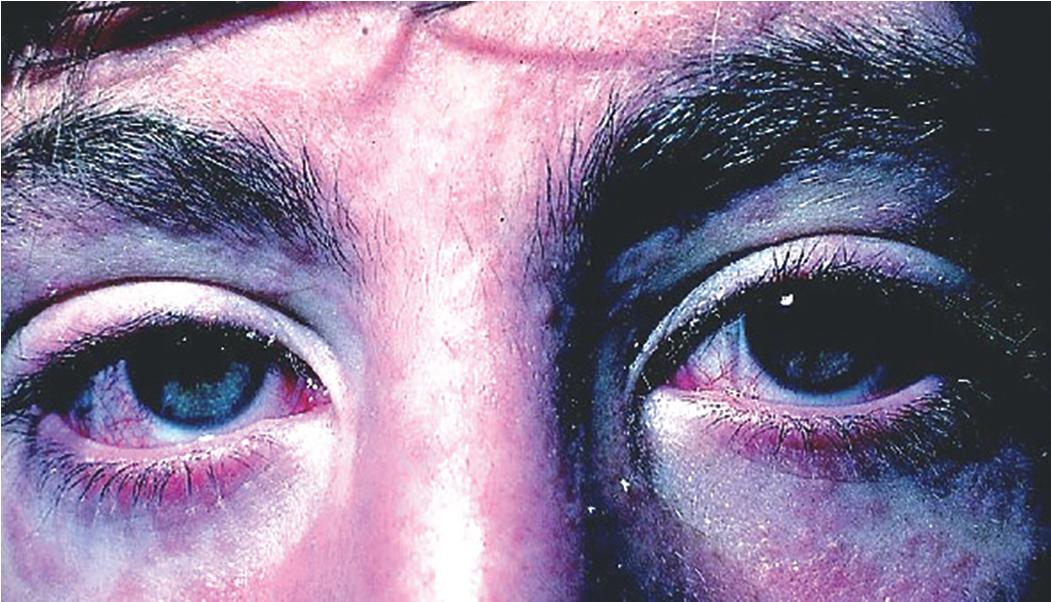
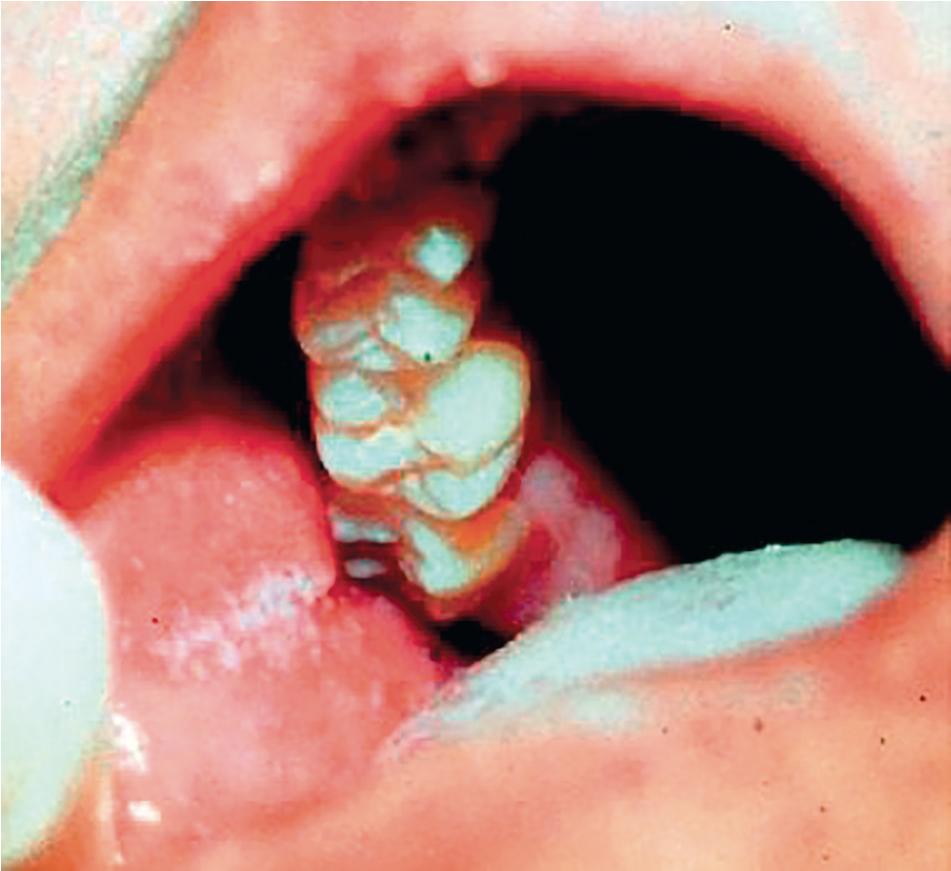
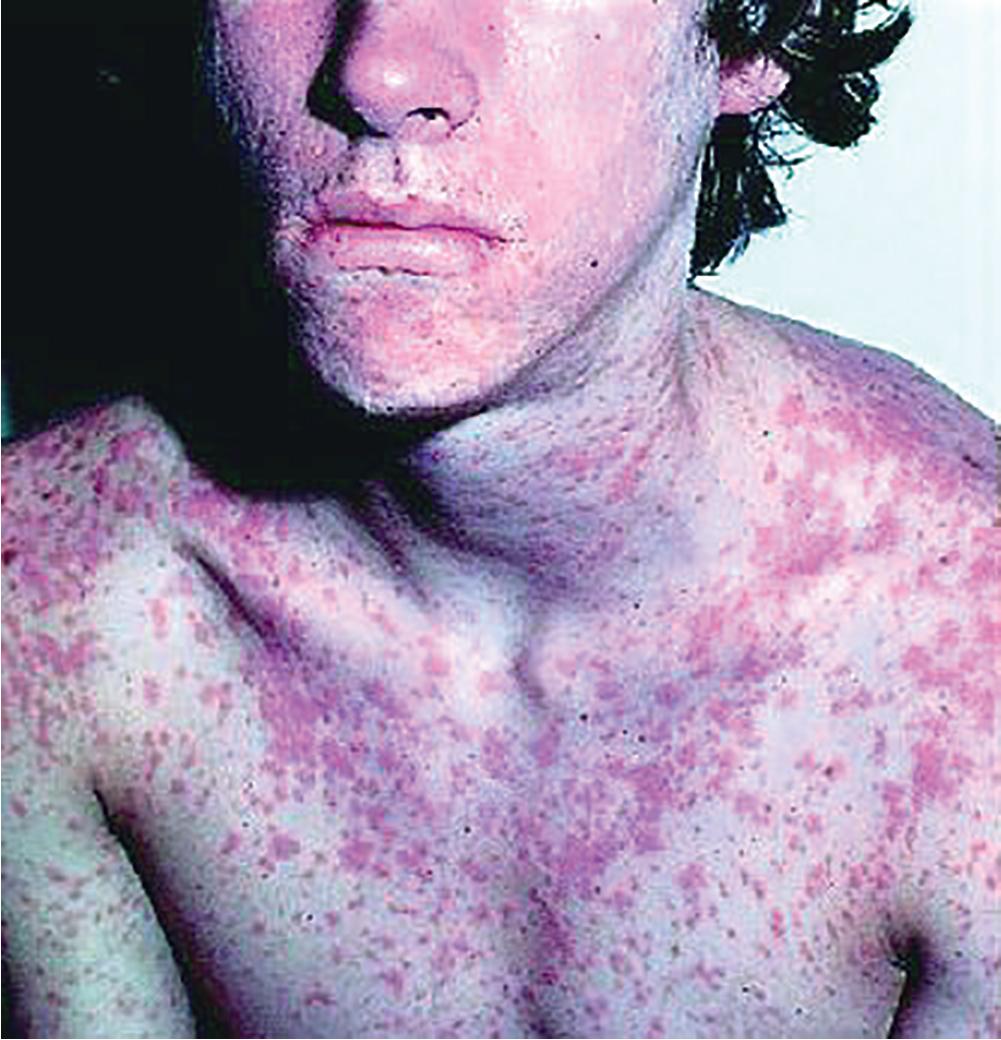
Rubeola infection can involve multiple organs. Respiratory infection can be the most common complication. Most fatalities are due to bronchopneumonia and laryngotracheobronchitis. Other complications include enteritis and encephalitis ( ).
The classic lesion of varicella (chickenpox) is a vesicle with an erythematous base ( Fig. 55.4 )—“teardrop on a rose petal.” Lesions begin at the hairline and progress cephalocaudally in three crops, giving the appearance of lesions of different ages ( Fig. 55.5 ). The exanthem appears initially as thin-walled vesicles that rapidly rupture, leaving shallow, painful ulcers ( Fig. 55.6 ). Superinfection can lead to cellulitis, necrotizing fasciitis, hemorrhagic varicella ( Fig. 55.7 ), and purpura fulminans ( Fig. 55.e1 ).
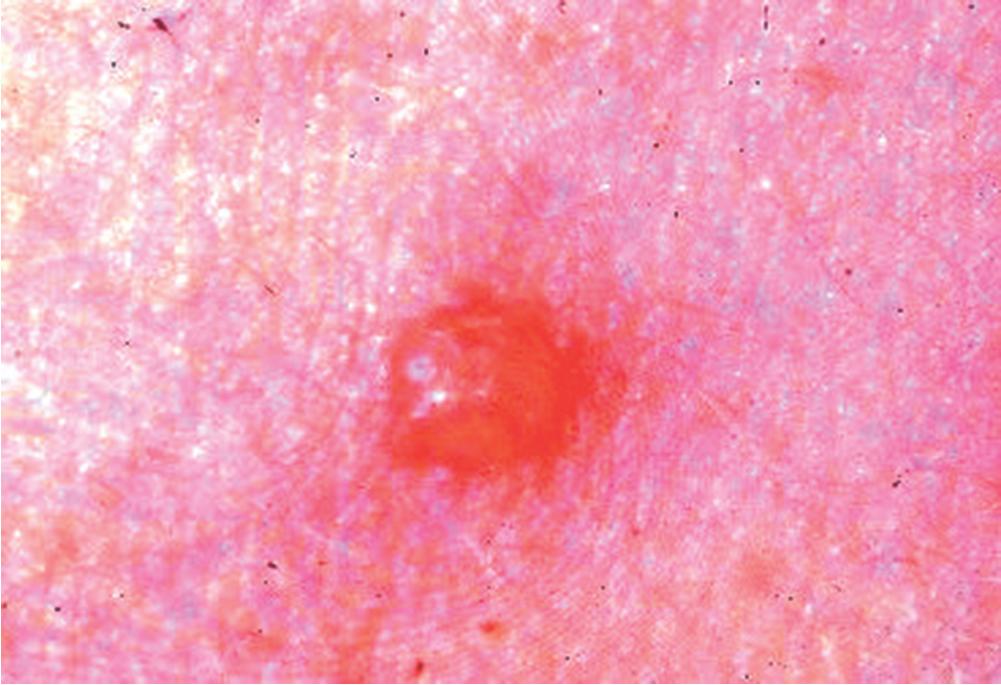
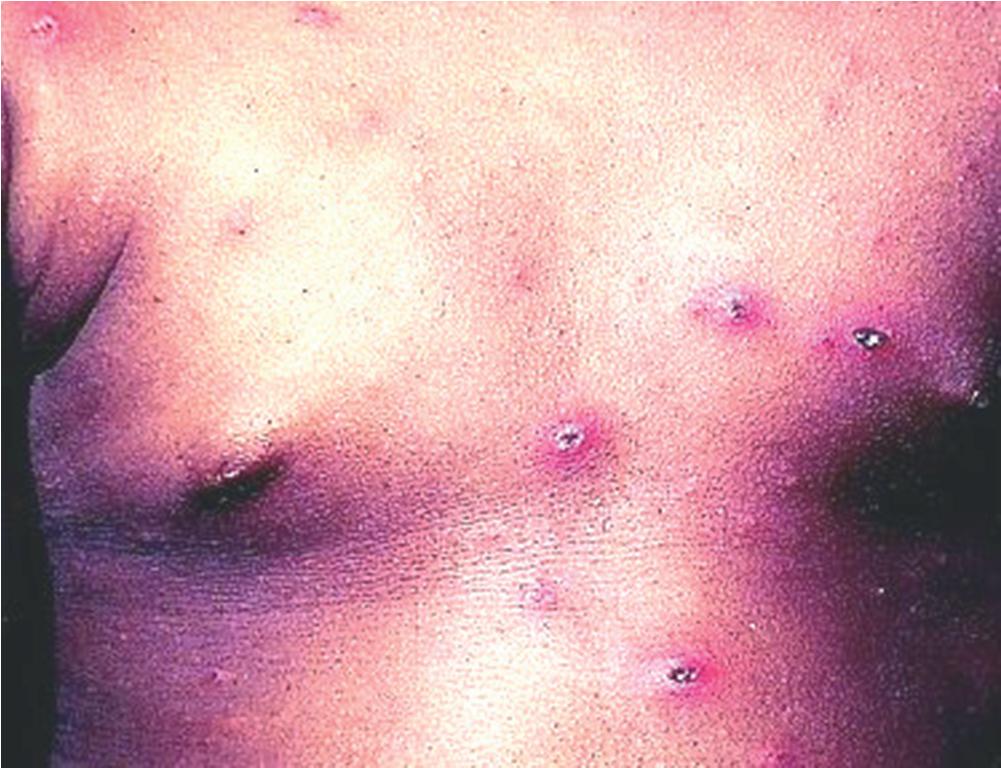
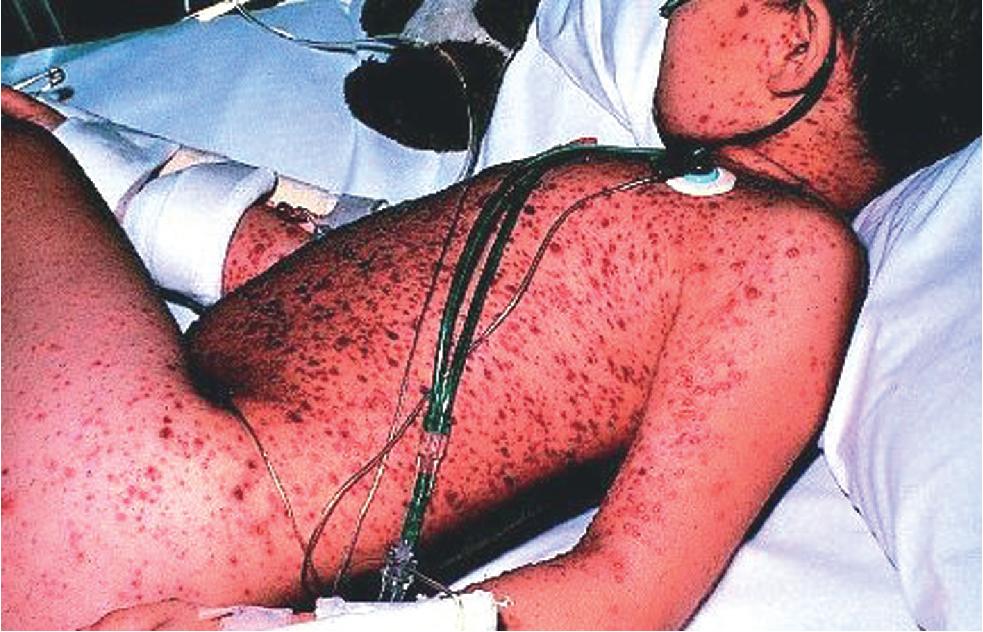
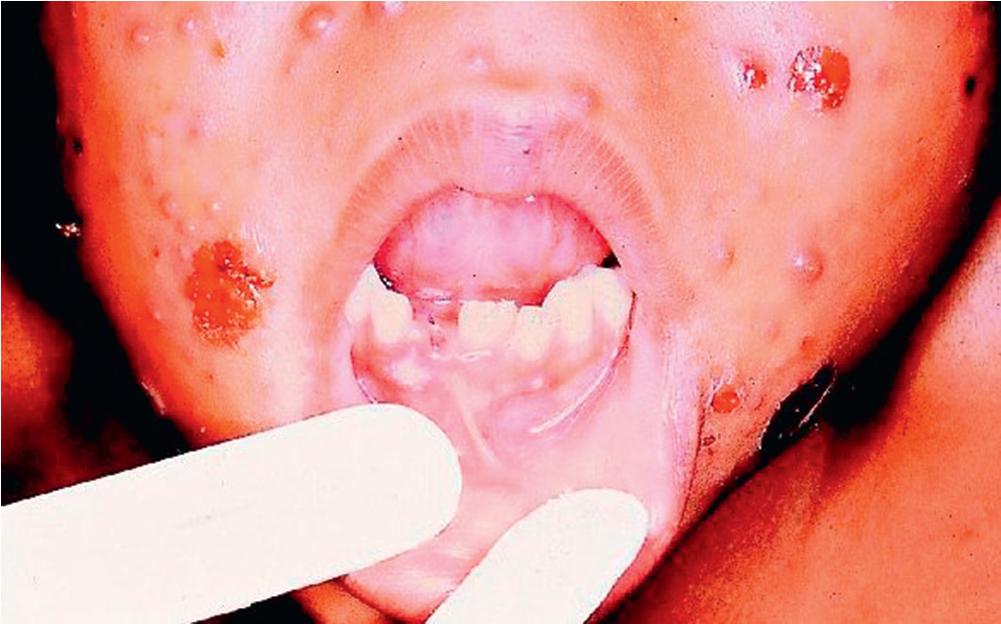
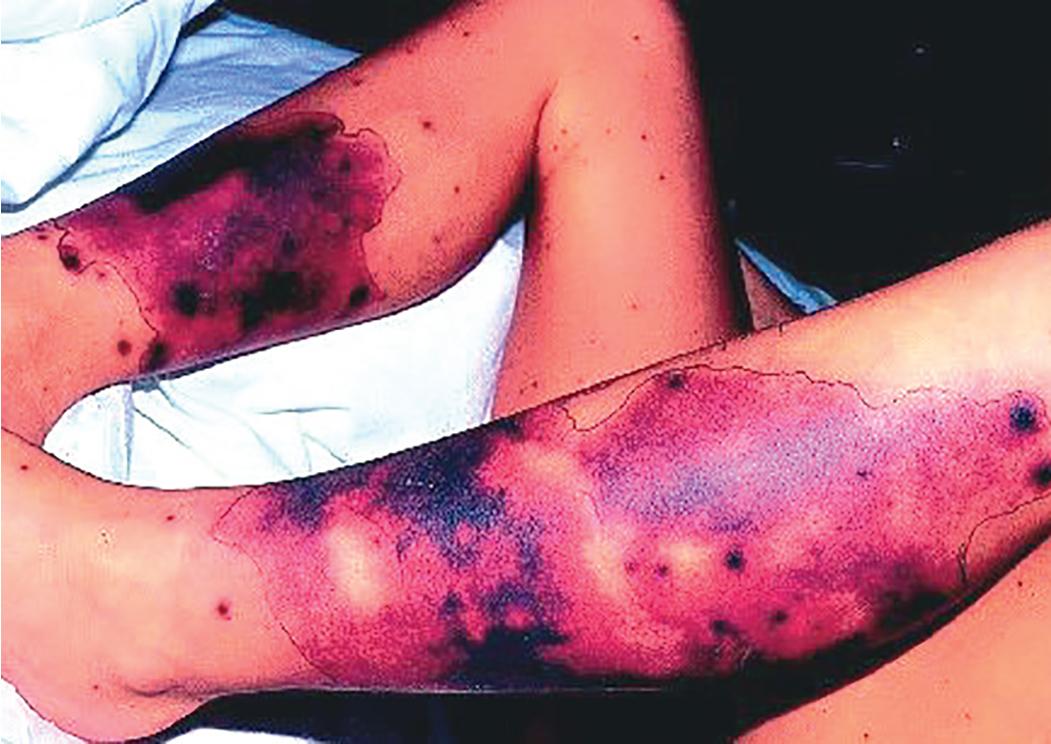
Coxsackie A16 (hand, foot, and mouth disease) produces a nonspecific prodromal illness in which oral and skin lesions develop in 1 to 2 days. Oral lesions consist of shallow ulcers with a surrounding red halo often seen on the gingiva ( Fig. 55.8 A), buccal mucosa, soft palate ( Fig. 55.8 B), tonsillar pillars, and tongue. Skin lesions begin as erythematous macules that progress to thick-walled vesicles on the palmar surface of hands and fingers and the plantar surface of feet and toes ( Fig. 55.9 A and B). Occasionally, the buttocks are involved. It is highly contagious. Symptomatic therapy is sufficient.
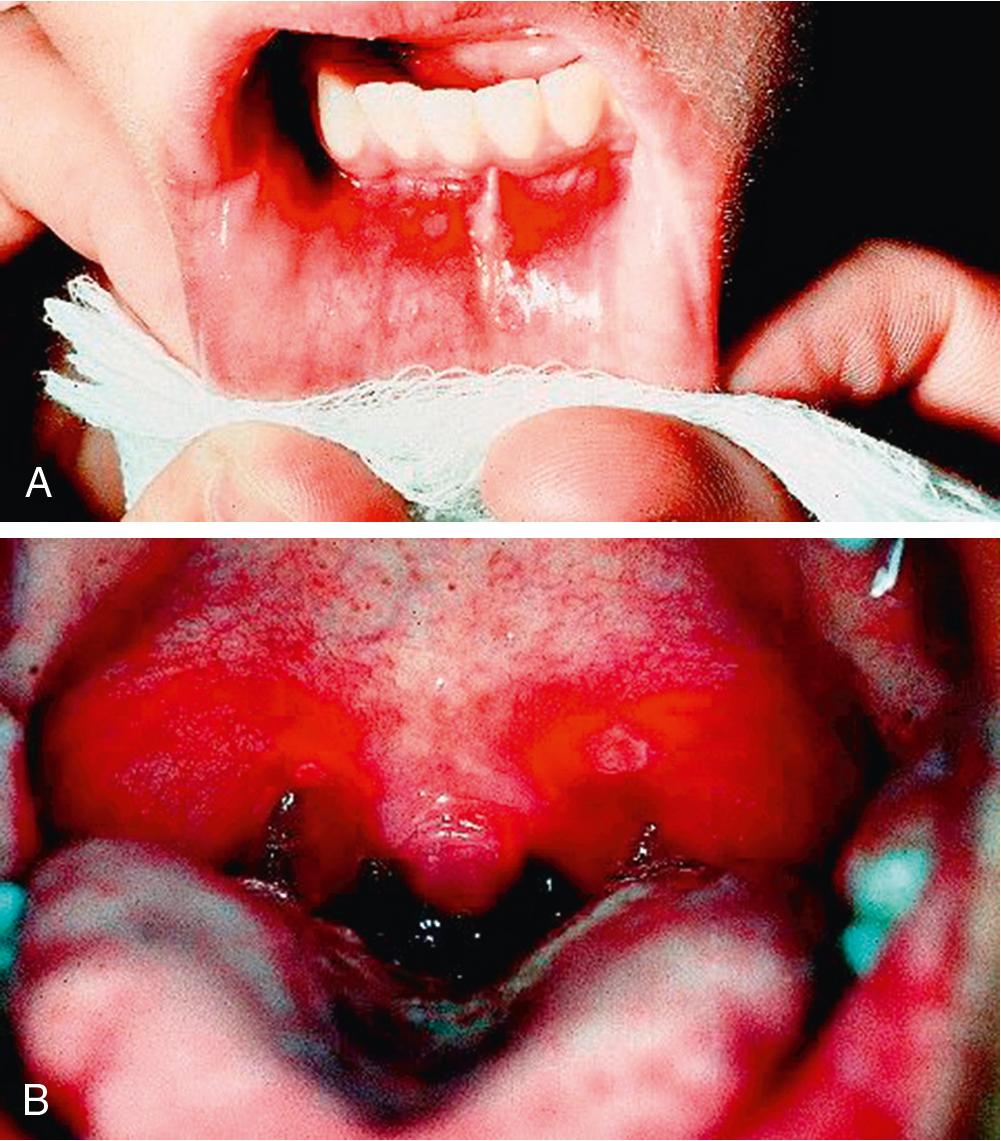
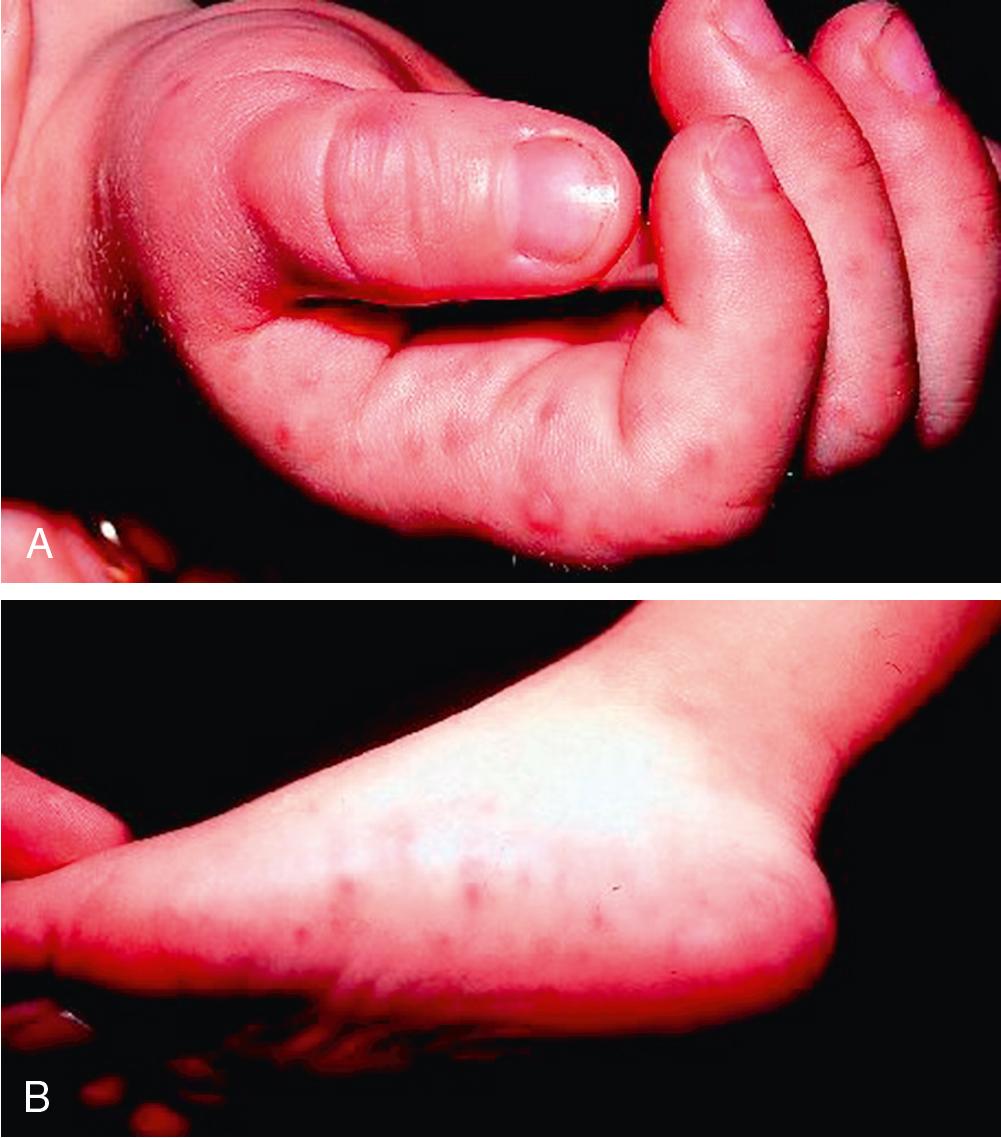
The coronavirus 2 (SARS-CoV-2) produced the coronavirus disease 2019 (COVID-19), first reported in Wuhan China in 2019, and evolved into a global pandemic. This virus causes not only respiratory disease but also causes a multisystem inflammatory disease that is distinct from the typical viral pneumonia. There can be a dermatologic presentation known as acute acro-ischemia and COVID toes. COVID toes have been reported in children and adults ( Fig. 55.10 ). The lesions are erythematous to purple purpuric macules, papules, and/or vesicles. These acral findings typically present late in the disease, which may account for some patients testing negative for COVID-19 ( ).
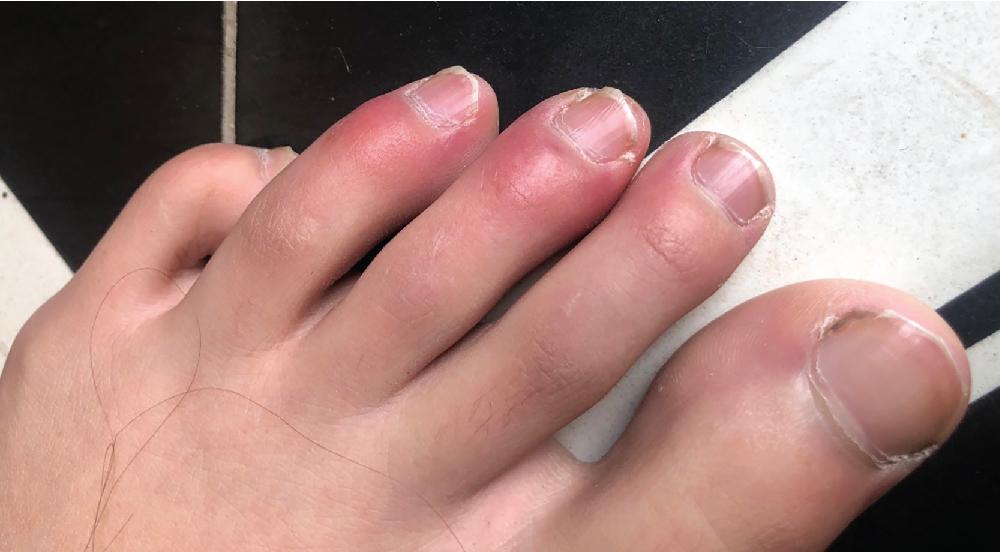
Human immunodeficiency virus (HIV)–infected patients are at risk for infections of common pathogens and opportunistic infections such as Pneumocystis jirovecii, Mycobacterium avium complex, candida ( Fig. 55.11 A and B), herpes simplex virus (HSV), Cryptococcus, toxoplasma, cryptosporidium, cytomegalovirus, and extensive involvement with Molluscum contagiosum ( Fig. 55.12 ). All are potentially serious pathogens.
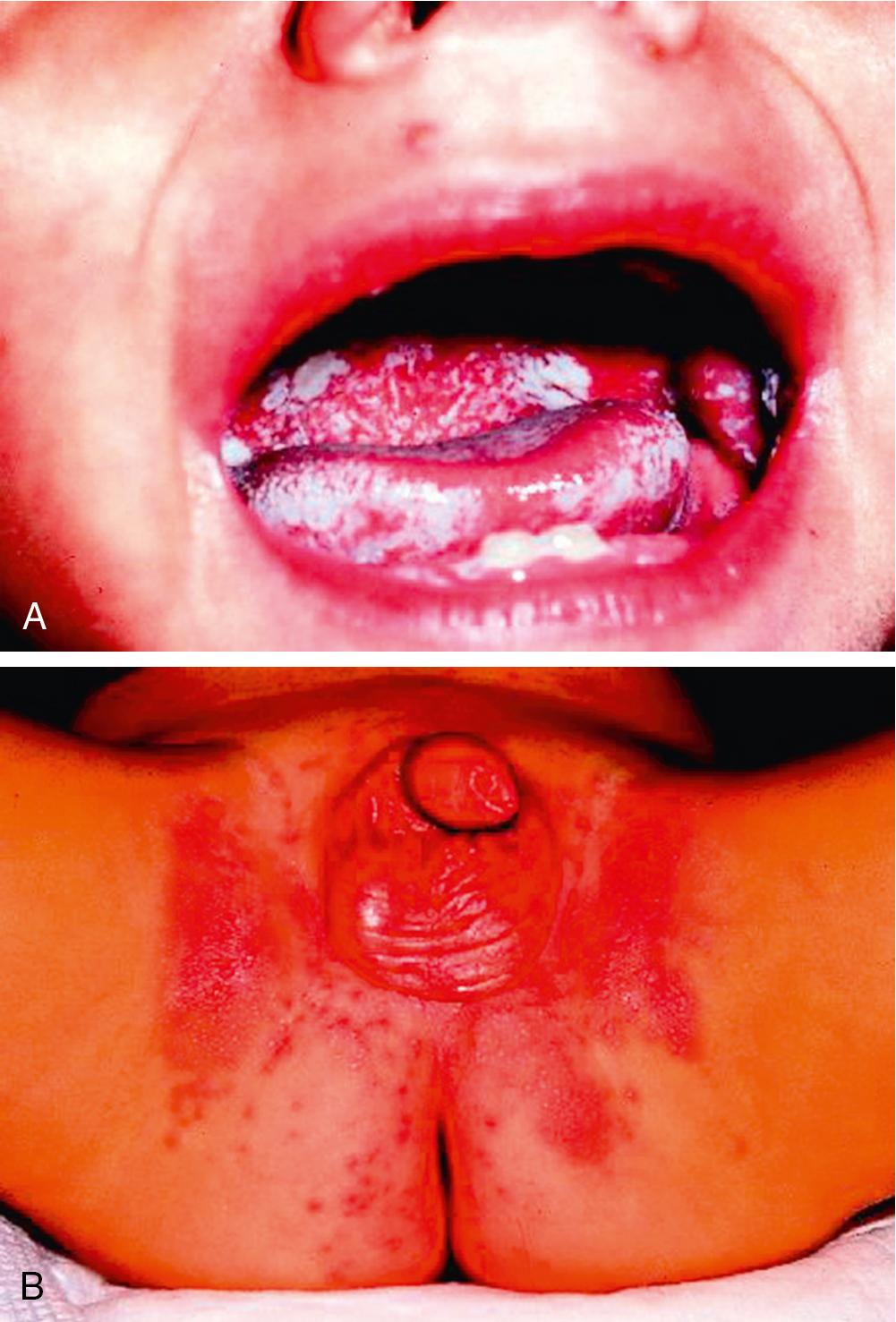
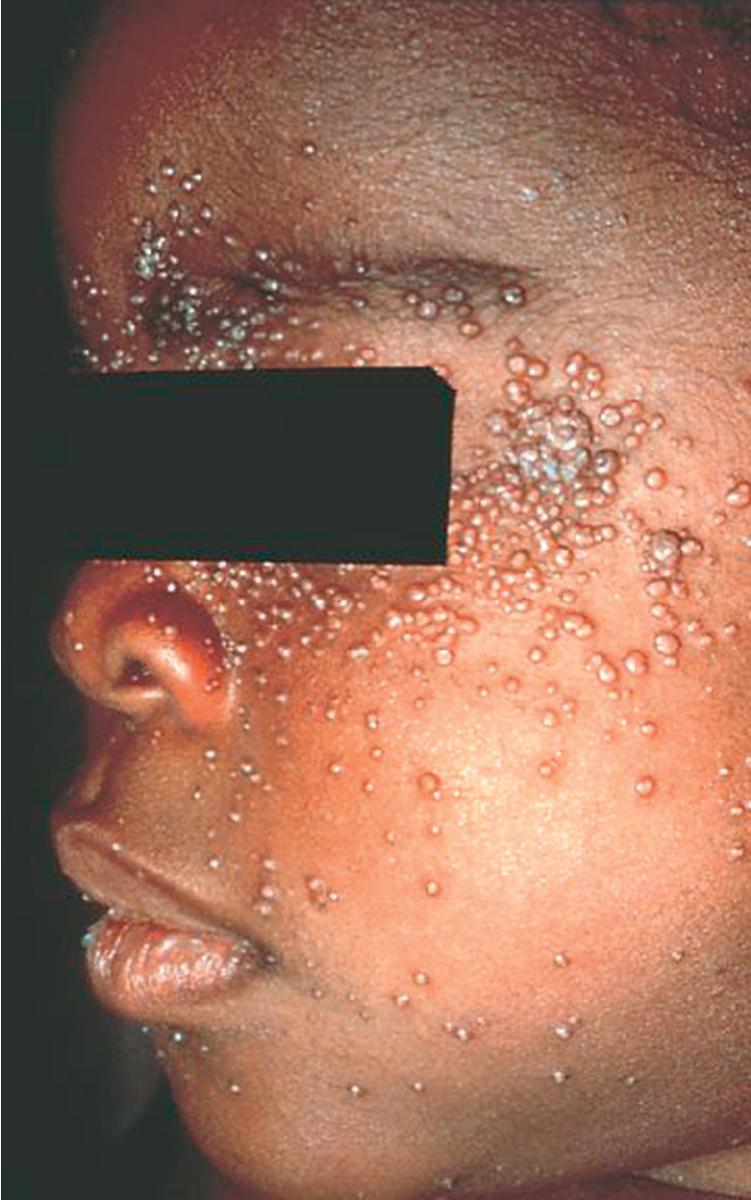
Rickettsia rickettsii is the causative organism transmitted to humans from an infected tick bite, causing Rocky Mountain spotted fever (RMSF). Epithelial invasion causes vasculitis, inflammation, thrombosis, and vascular leakage. The incubation period is 2 to 14 days. Fever, severe headache, and nonspecific symptoms herald the characteristic rash beginning as erythematous macules on the wrists, ankles, palms, and soles of the feet, spreading centripetally, and becoming petechial ( Fig. 55.13 ).
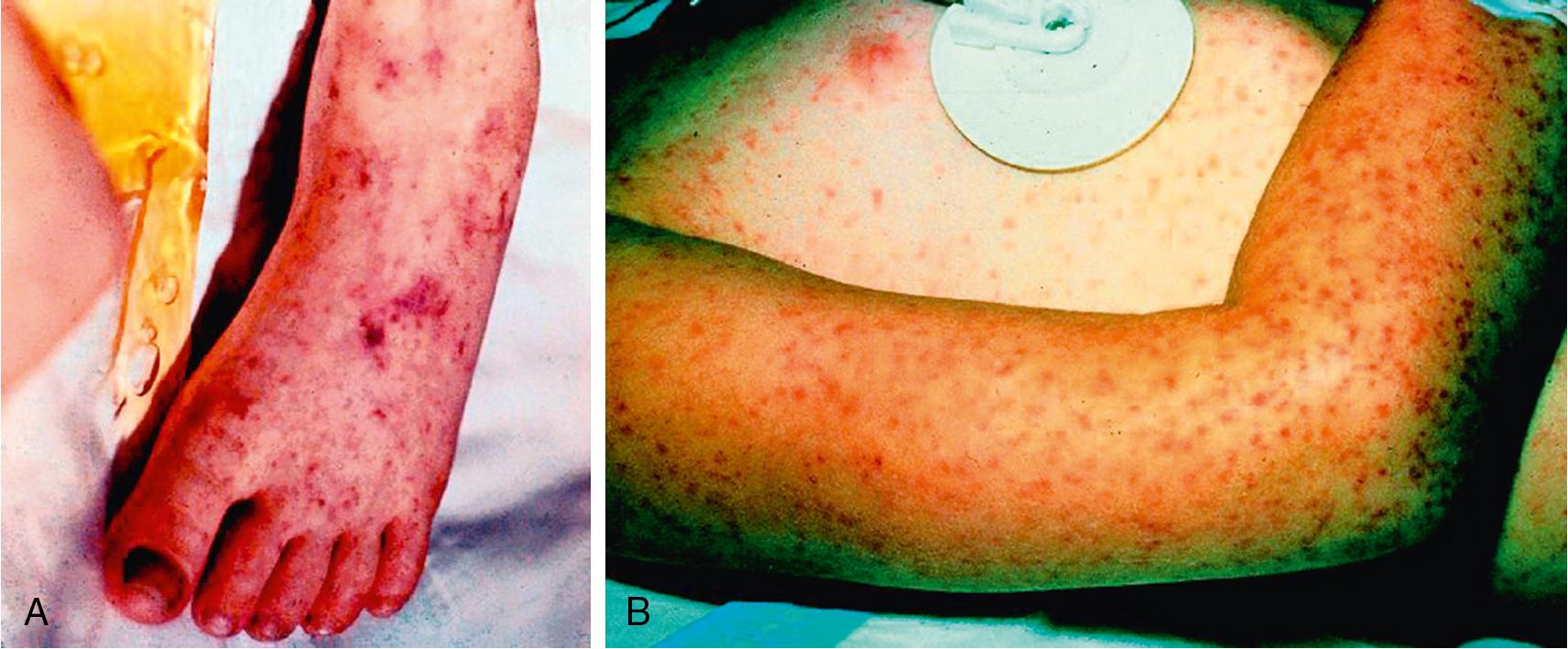
Scabies is a highly contagious infestation caused by Acarus scabiei. The mite burrows under the skin to produce an intensely pruritic eruption, generally 4 to 6 weeks after contact. The rash may consist of vesicles, papules, and burrows in the webs of the fingers ( Fig. 55.14 ) and toes, axillae, wrists, elbows, nipples, waist, groin, and buttocks. Distribution of the rash differs in infants and toddlers, with more generalization of the eruption ( Fig. 55.15 A and B). Nosocomial outbreaks can affect both patients and healthcare workers. Infection control measures, including isolation precautions and preemptive treatment of contact persons, should be initiated for outbreak control ( ; ).
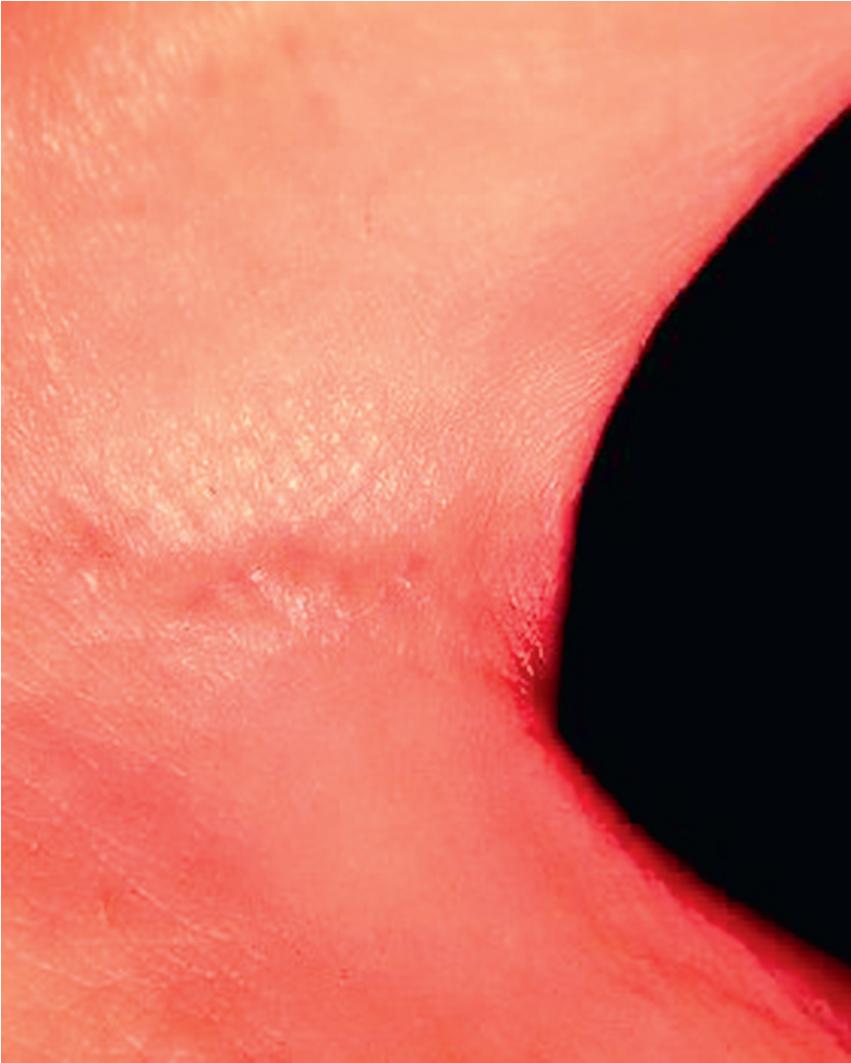
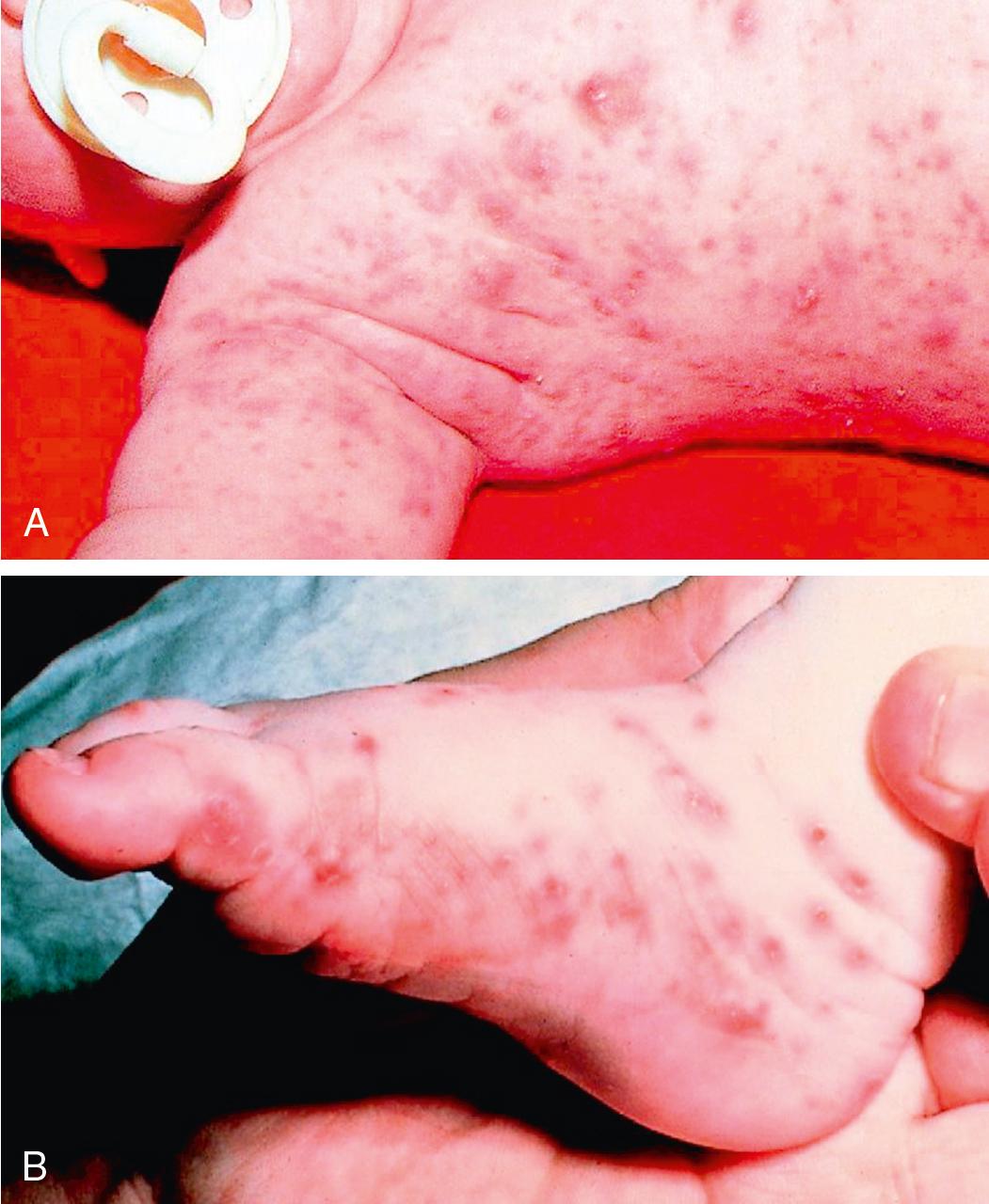
Molluscum is a contagious pox virus infection with dome-shaped papules and a waxy surface, often with central umbilication ( Fig. 55.16 ; also see Fig. 55.12 ). Lesions may occur singly or in clusters. Spread occurs with scratching. Transmission is via direct skin-to-skin contact and fomites. Genital lesions may be present in sexually active persons. Genital molluscum contagiosum may be a sign of sexual abuse in children, particularly if the lesions are isolated to the genital area. However auto-inoculation in the diaper area of young children is common ( ; ). Curetting after application of topical anesthetic is curative.
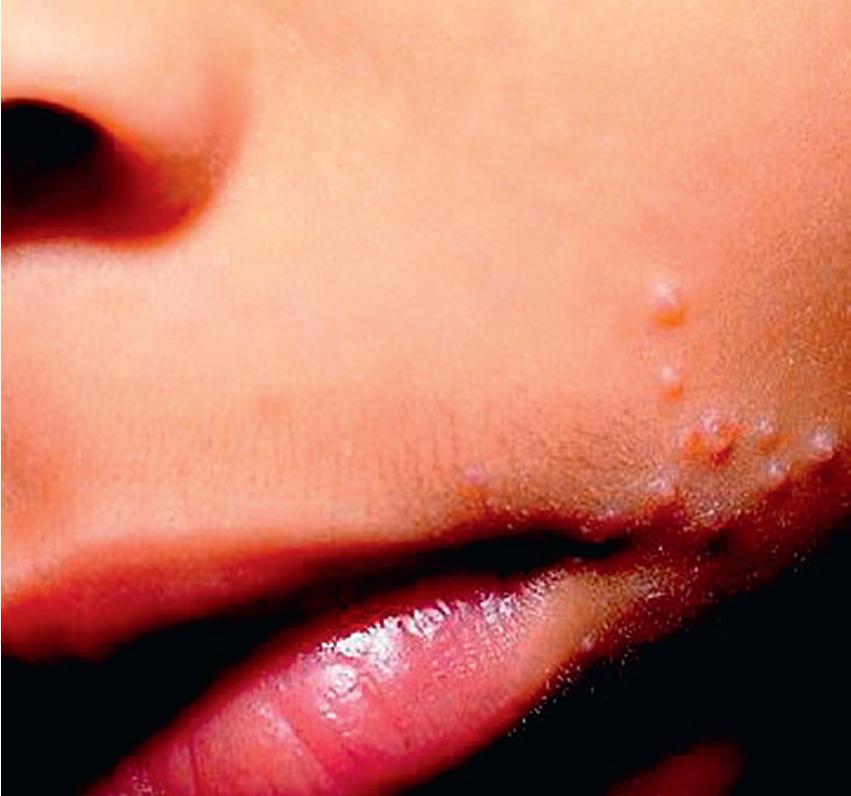
Become a Clinical Tree membership for Full access and enjoy Unlimited articles
If you are a member. Log in here